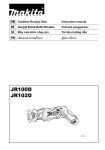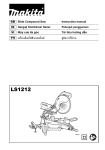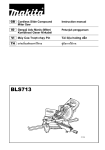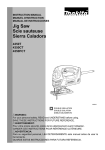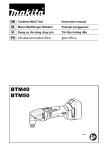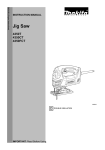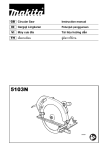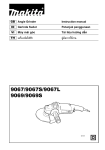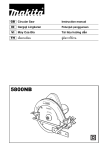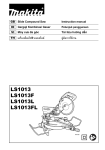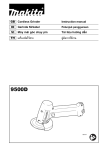Download Makita 4350T Instruction manual
Transcript
GB Jig Saw Instruction manual ID Gergaji Ukir Petunjuk penggunaan VI Maùy cöa loïng Taøi lieäu höôùng daãn TH 4350T 4350CT 4350FCT O 008003 3 2 1 1 008004 2 008005 4 5 3 008006 4 008007 8 6 7 7 5 008008 6 008009 11 9 7 2 9 10 008010 8 008011 10 9 12 9 008012 14 13 15 16 10 008013 10 9 9 12 12 11 008014 12 008015 008016 14 008017 17 13 18 9 15 008018 16 001921 3 19 18 17 001922 18 008019 10 20 12 19 008020 21 20 008021 22 23 21 21 008022 22 008023 12 23 4 008024 24 24 008025 28 25 26 9 27 25 008026 29 27 26 008027 9 008028 5 ENGLISH (Original instructions) Explanation of general view 1. 2. 3. 4. 5. 6. 7. 8. 9. 10. 11. 12. 13. 14. 15. 16. 17. 18. 19. 20. Cutting action changing lever Switch trigger Lock button Speed adjusting dial Tool opener Blade clamp Jig saw blade Protrusions Base Hex wrench Cutting line Bolt Graduation Bevel slot Gear housing V-notch Starting hole Dust nozzle Hose for vacuum cleaner Rip fence 21. 22. 23. 24. 25. 26. 27. 28. 29. Fence guide Threaded knob Circular guide pin Rule bar Screw Guide rail adapter Guide rail Cover plate Anti-splintering device SPECIFICATIONS Model 4350T 4350CT Length of stroke 26 mm 26 mm 26 mm Wood 135 mm 135 mm 135 mm Steel 10 mm 10 mm 10 mm Aluminum 20 mm 20 mm 20 mm Strokes per minute (min-1) 2,800 800 - 2,800 800 - 2,800 Overall length 236 mm 236 mm 236 mm Net weight 2.6 kg 2.6 kg 2.6 kg Max. cutting capacities Safety class 4350FCT /II • Due to our continuing program of research and development, the specifications herein are subject to change without notice. • Specifications may differ from country to country. • Weight according to EPTA-Procedure 01/2003 Symbols END201-5 The following show the symbols used for the equipment. Be sure that you understand their meaning before use. The term “power tool” in the warnings refers to your mains-operated (corded) power tool or battery-operated (cordless) power tool. ... Read instruction manual. ............. DOUBLE INSULATION Intended use ENE019-1 The tool is intended for the sawing of wood, plastic and metal materials. As a result of the extensive accessory and saw blade program, the tool can be used for many purposes and is very well suited for curved or circular cuts. Power supply ENF002-1 The tool should be connected only to a power supply of the same voltage as indicated on the nameplate, and can only be operated on single-phase AC supply. They are double-insulated in accordance with European Standard and can, therefore, also be used from sockets without earth wire. General Power Tool Safety Warnings GEA005-2 WARNING Read all safety warnings and all instructions. Failure to follow the warnings and instructions may result in electric shock, fire and/or serious injury. 6 Save all warnings and instructions for future reference. Work area safety 1. Keep work area clean and well lit. Cluttered or dark areas invite accidents. 2. Do not operate power tools in explosive atmospheres, such as in the presence of flammable liquids, gases or dust. Power tools create sparks which may ignite the dust or fumes. 3. Keep children and bystanders away while operating a power tool. Distractions can cause you to lose control. Electrical safety 4. Power tool plugs must match the outlet. Never modify the plug in any way. Do not use any adapter plugs with earthed (grounded) power tools. Unmodified plugs and matching outlets will reduce risk of electric shock. 5. Avoid body contact with earthed or grounded surfaces such as pipes, radiators, ranges and refrigerators. There is an increased risk of electric shock if your body is earthed or grounded. 6. Do not expose power tools to rain or wet conditions. Water entering a power tool will increase the risk of electric shock. 7. Do not abuse the cord. Never use the cord for carrying, pulling or unplugging the power tool. Keep cord away from heat, oil, sharp edges or moving parts. Damaged or entangled cords increase the risk of electric shock. 8. When operating a power tool outdoors, use an extension cord suitable for outdoor use. Use of a cord suitable for outdoor use reduces the risk of electric shock. 9. If operating a power tool in a damp location is unavoidable, use a ground fault circuit interrupter (GFCI) protected supply. Use of an GFCI reduces the risk of electric shock. Personal safety 10. Stay alert, watch what you are doing and use common sense when operating a power tool. Do not use a power tool while you are tired or under the influence of drugs, alcohol or medication. A moment of inattention while operating power tools may result in serious personal injury. 11. Use personal protective equipment. Always wear eye protection. Protective equipment such as dust mask, non-skid safety shoes, hard hat, or hearing protection used for appropriate conditions will reduce personal injuries. 12. Prevent unintentional starting. Ensure the switch is in the off-position before connecting to power source and/or battery pack, picking up or carrying the tool. Carrying power tools with your finger on the switch or energising power tools that have the switch on invites accidents. 13. Remove any adjusting key or wrench before turning the power tool on. A wrench or a key left attached to a rotating part of the power tool may result in personal injury. 14. Do not overreach. Keep proper footing and balance at all times. This enables better control of the power tool in unexpected situations. 15. Dress properly. Do not wear loose clothing or jewellery. Keep your hair, clothing, and gloves away from moving parts. Loose clothes, jewellery or long hair can be caught in moving parts. 16. If devices are provided for the connection of dust extraction and collection facilities, ensure these are connected and properly used. Use of dust collection can reduce dust-related hazards. Power tool use and care 17. Do not force the power tool. Use the correct power tool for your application. The correct power tool will do the job better and safer at the rate for which it was designed. 18. Do not use the power tool if the switch does not turn it on and off. Any power tool that cannot be controlled with the switch is dangerous and must be repaired. 19. Disconnect the plug from the power source and/or the battery pack from the power tool before making any adjustments, changing accessories, or storing power tools. Such preventive safety measures reduce the risk of starting the power tool accidentally. 20. Store idle power tools out of the reach of children and do not allow persons unfamiliar with the power tool or these instructions to operate the power tool. Power tools are dangerous in the hands of untrained users. 21. Maintain power tools. Check for misalignment or binding of moving parts, breakage of parts and any other condition that may affect the power tool’s operation. If damaged, have the power tool repaired before use. Many accidents are caused by poorly maintained power tools. 22. Keep cutting tools sharp and clean. Properly maintained cutting tools with sharp cutting edges are less likely to bind and are easier to control. 23. Use the power tool, accessories and tool bits etc. in accordance with these instructions, taking into account the working conditions and the work to be performed. Use of the power tool for operations different from those intended could result in a hazardous situation. Service 24. Have your power tool serviced by a qualified repair person using only identical replacement parts. This will ensure that the safety of the power tool is maintained. 25. Follow instruction for lubricating and changing accessories. 26. Keep handles dry, clean and free from oil and grease. SPECIFIC SAFETY RULES GEB016-2 DO NOT let comfort or familiarity with product (gained from repeated use) replace strict adherence to jig saw safety rules. If you use this tool unsafely or incorrectly, you can suffer serious personal injury. 1. Hold power tool by insulated gripping surfaces, when performing an operation where the cutting accessory may contact hidden wiring or its own cord. Cutting accessory contacting a “live” wire may make exposed metal parts of the power tool “live” and could give the operator an electric shock. 2. Use clamps or another practical way to secure and support the workpiece to a stable platform. Holding the work by hand or against your body leaves it unstable and may lead to loss of control. 3. Always use safety glasses or goggles. Ordinary eye or sun glasses are NOT safety glasses. 4. Avoid cutting nails. Inspect workpiece for any nails and remove them before operation. 5. Do not cut oversize workpiece. 6. Check for the proper clearance beyond the workpiece before cutting so that the blade will not strike the floor, workbench, etc. 7. Hold the tool firmly. 8. Make sure the blade is not contacting the workpiece before the switch is turned on. 9. Keep hands away from moving parts. 10. Do not leave the tool running. Operate the tool only when hand-held. 11. Always switch off and wait for the blade to come to a complete stop before removing the blade from the workpiece. 7 12. Do not touch the blade or the workpiece immediately after operation; they may be extremely hot and could burn your skin. 13. Do not operate the tool at no-load unnecessarily. 14. Some material contains chemicals which may be toxic. Take caution to prevent dust inhalation and skin contact. Follow material supplier safety data. 15. Always use the correct dust mask/respirator for the material and application you are working with. SAVE THESE INSTRUCTIONS. WARNING: MISUSE or failure to follow the safety rules stated in this instruction manual may cause serious personal injury. Speed adjusting dial For 4350CT, 4350FCT (Fig. 3) The tool speed can be infinitely adjusted between 800 and 2,800 strokes per minute by turning the adjusting dial. Higher speed is obtained when the dial is turned in the direction of number 5; lower speed is obtained when it is turned in the direction of number 1. Refer to the table to select the proper speed for the workpiece to be cut. However, the appropriate speed may differ with the type or thickness of the workpiece. In general, higher speeds will allow you to cut workpieces faster but the service life of the blade will be reduced. Workpiece to be cut FUNCTIONAL DESCRIPTION CAUTION: • Always be sure that the tool is switched off and unplugged before adjusting or checking function on the tool. Selecting the cutting action (Fig. 1) This tool can be operated with an orbital or a straight line (up and down) cutting action. The orbital cutting action thrusts the blade forward on the cutting stroke and greatly increases cutting speed. To change the cutting action, just turn the cutting action changing lever to the desired cutting action position. Refer to the table to select the appropriate cutting action. Position 0 I II III Cutting action Applications Straight line cutting action For cutting mild steel, stainless steel and plastics. For clean cuts in wood and plywood. Small orbit cutting action For cutting mild steel, aluminum and hard wood. Medium orbit cutting action For cutting wood and plywood. For fast cutting in aluminum and mild steel. Large orbit cutting action For fast cutting in wood and plywood. 006376 Switch action (Fig. 2) CAUTION: • Before plugging in the tool, always check to see that the switch trigger actuates properly and returns to the “OFF” position when released. To start the tool, simply pull the switch trigger. Release the switch trigger to stop. For continuous operation, pull the switch trigger and then push in the lock button. To stop the tool from the locked position, pull the switch trigger fully, then release it. 8 Number on adjusting dial Wood 4-5 Mild steel 3-5 Stainless steel 3-4 Aluminum 3-5 Plastics 1-4 006368 CAUTION: • The speed adjusting dial can be turned only as far as 5 and back to 1. Do not force it past 5 or 1, or the speed adjusting function may no longer work. The tools equipped with electronic function are easy to operate because of the following features. Constant speed control Electronic speed control for obtaining constant speed. Possible to get fine finish, because the rotating speed is kept constant even under load condition. Soft start feature Safety and soft start because of suppressed starting shock. Lighting up the lamps For 4350FCT only CAUTION: • Do not look in the light or see the source of light directly. To turn on the lamp, pull the trigger. Release the trigger to turn it off. NOTE: • Use a dry cloth to wipe the dirt off the lens of lamp. Be careful not to scratch the lens of lamp, or it may lower the illumination. ASSEMBLY CAUTION: • Always be sure that the tool is switched off and unplugged before carrying out any work on the tool. Installing or removing saw blade CAUTION: • Always clean out all chips or foreign matter adhering to the blade and/or blade holder. Failure to do so may cause insufficient tightening of the blade, resulting in a serious personal injury. • Do not touch the blade or the workpiece immediately after operation; they may be extremely hot and could burn your skin. • Tighten the saw blade securely. Failure to do so may cause a serious injury. • When you remove the saw blade, be careful not to hurt your fingers with the top of the blade or the tips of workpiece. To install the blade, open the tool opener to the position shown in the figure. (Fig. 4) Keeping that situation, insert the saw blade into the blade clamp as far as the two protrusions of the blade can not be seen. (Fig. 5) Return the tool opener to its original position. After installing, always make sure that the blade is securely held in place by trying to pull it out. CAUTION: • Do not open the tool opener excessively, or it may cause tool damage. To remove the blade, open the tool opener to the position shown in the figure. Pull the saw blade out toward the base. (Fig. 6) NOTE: • Occasionally lubricate the roller. Hex wrench storage (Fig. 7) When not in use, the hex wrench can be conveniently stored. OPERATION CAUTION: • Hold the tool firmly with one hand on the main handle when performing the tool. If necessary, the front part of the tool may be supported by the other hand. • Always hold the base flush with the workpiece. Failure to do so may cause blade breakage, resulting in a serious injury. (Fig. 8) Turn the tool on and wait until the blade attains full speed. Then rest the tool base flat on the workpiece and gently move the tool forward along the previously marked cutting line. When cutting curves, advance the tool very slowly. Bevel cutting CAUTION: • Always be sure that the tool is switched off and unplugged before tilting the base. With the base tilted, you can make bevel cuts at any angle between 0° and 45° (left or right). (Fig. 9) Loosen the bolt on the back of the base with the hex wrench. Move the base so that the bolt is positioned in the center of the bevel slot in the base. (Fig. 10) Tilt the base until the desired bevel angle is obtained. The V-notch of the gear housing indicates the bevel angle by graduations. Then tighten the bolt firmly to secure the base. (Fig. 11) Front flush cuts (Fig. 12) Loosen the bolt on the back of the base with the hex wrench and slide the base all the way back. Then tighten the bolt to secure the base. Cutouts Cutouts can be made with either of two methods A or B. A) Boring a starting hole: (Fig. 13) For internal cutouts without a lead-in cut from an edge, pre-drill a starting hole 12 mm or more in diameter. Insert the blade into this hole to start your cut. B) Plunge cutting: (Fig. 14) You need not bore a starting hole or make a lead-in cut if you carefully do as follows. (1) Tilt the tool up on the front edge of the base with the blade point positioned just above the workpiece surface. (2) Apply pressure to the tool so that the front edge of the base will not move when you switch on the tool and gently lower the back end of the tool slowly. (3) As the blade pierces the workpiece, slowly lower the base of the tool down onto the workpiece surface. (4) Complete the cut in the normal manner. Finishing edges (Fig. 15) To trim edges or make dimensional adjustments, run the blade lightly along the cut edges. Metal cutting Always use a suitable coolant (cutting oil) when cutting metal. Failure to do so will cause significant blade wear. The underside of the workpiece can be greased instead of using a coolant. Dust extraction (Fig. 16 & 17) The dust nozzle (accessory) is recommended to perform clean cutting operations. To attach the dust nozzle on the tool, insert the hook of dust nozzle into the hole in the base. The dust nozzle can be installed on either left or right side of the base. Then connect a Makita vacuum cleaner to the dust nozzle. (Fig. 18) CAUTION: • If you try to remove the dust nozzle forcibly, the hook of the dust nozzle can be diminished and removed unintentionally during operation. Rip fence set (optional accessory) CAUTION: • Always be sure that the tool is switched off and unplugged before installing or removing accessories. 1. Straight cuts (Fig. 19 & 20) When repeatedly cutting widths of 160 mm or less, use of the rip fence will assure fast, clean, straight cuts. To install, insert the rip fence into the rectangular hole on the side of the tool base with the fence guide facing down. Slide the rip fence to the desired cutting width position, then tighten the bolt to secure it. 2. Circular cuts (Fig. 21 & 22) When cutting circles or arcs of 170 mm or less in radius, install the rip fence as follows. Insert the rip fence into the rectangular hole on the side of the base with the fence guide facing up. Insert the circular guide pin through either of the two holes on the fence 9 guide. Screw the threaded knob onto the pin to secure the pin. Now slide the rip fence to the desired cutting radius, and tighten the bolt to secure it in place. Then move the base all the way forward. NOTE: • Always use blades No. B-17, B-18, B-26 or B-27 when cutting circles or arcs. Guide rail adapter set (accessory) (Fig. 23) When cutting parallel and uniform width or cutting straight, the use of the guide rail and the guide rail adapter will assure the production of fast and clean cuts. To install the guide rail adapter, insert the rule bar into the square hole of the base as far as it goes. Secure the bolt with the hex wrench securely. (Fig. 24) Install the guide rail adapter on the rail of the guide rail. Insert the rule bar into the square hole of the guide rail adapter. Put the base to the side of the guide rail, and secure the bolt securely. (Fig. 25) CAUTION: • Always use blades No. B-8, B-13, B-16, B-17 or 58 when using the guide rail and the guide rail adapter. Cover plate (Fig. 26) Use the cover plate when cutting decorative veneers, plastics, etc. It protects sensitive or delicate surfaces from damage. Fit it on the back of the tool base. Anti-splintering device (Fig. 27) For splinter-free cuts, the anti-splintering device can be used. To install the anti-splintering device, move the tool base all the way forward and fit it from the back of tool base. When you use the cover plate, install the antisplintering device onto the cover plate. CAUTION: • The anti-splintering device cannot be used when making bevel cuts. MAINTENANCE CAUTION: • Always be sure that the tool is switched off and unplugged before attempting to perform inspection or maintenance. To maintain product SAFETY and RELIABILITY, repairs, carbon brush inspection and replacement, any other maintenance or adjustment should be performed by Makita Authorized Service Centers, always using Makita replacement parts. OPTIONAL ACCESSORIES CAUTION: • These accessories or attachments are recommended for use with your Makita tool specified in this manual. The use of any other accessories or attachments might present a risk of injury to persons. Only use accessory or attachment for its stated purpose. If you need any assistance for more details regarding these accessories, ask your local Makita Service Center. • Jig saw blades 10 • • • • • • • • Hex wrench 4 Rip fence (guide rule) set Guide rail adapter set Guide rail set Anti-splintering device Dust nozzle Cover plate Hose (For vacuum cleaner) NOTE: • Some items in the list may be included in the tool package as standard accessories. They may differ from country to country. BAHASA INDONESIA (Petunjuk Asli) Penjelasan tampilan keseluruhan 11. 12. 13. 14. 15. 16. 17. 18. 19. Garis pemotongan Baut Garis tahapan Slot kemiringan Rumah gir Takik-V Lubang mulai Nozel debu Slang untuk mesin pembersih vakum 20. Rip fence (Penggaris pemandu) 1. Tuas pengubah kerja pemotongan 2. Picu sakelar 3. Tombol kunci 4. Tombol-putar penyetel kecepatan 5. Pembuka mesin 6. Klem bilah 7. Bilah gergaji ukir 8. Tonjolan 9. Alas 10. Kunci hex 21. 22. 23. 24. 25. 26. 27. 28. 29. Pemandu pagar Kenop berdrat Pasak pemandu lingkar Bilah penggaris Sekrup Adapter rel pemandu Rel pemandu Pelat penutup Perangkat anti-remuk SPESIFIKASI Model 4350T 4350CT Panjang langkah 26 mm 26 mm 26 mm Kayu 135 mm 135 mm 135 mm Baja 10 mm 10 mm 10 mm Aluminium 20 mm 20 mm 20 mm Langkah per menit (men-1) 2.800 800 - 2.800 800 - 2.800 Panjang keseluruhan 236 mm 236 mm 236 mm Berat bersih 2,6 kg 2,6 kg 2,6 kg Kemampuan pemotongan maks. Kelas keamanan 4350FCT /II • Karena kesinambungan program penelitian dan pengembangan kami, spesifikasi yang disebutkan di sini dapat berubah tanpa pemberitahuan. • Spesifikasi dapat berbeda dari satu negara ke negara lainnya. • Berat menurut Prosedur EPTA 01/2003 Simbol-simbol END201-5 Berikut ini adalah simbol-simbol yang digunakan pada mesin ini. Pastikan Anda mengerti makna masing-masing simbol sebelum menggunakan mesin ini. ... Baca petunjuk penggunaan. ............. ISOLASI GANDA Maksud penggunaan ENE019-1 Mesin ini dimaksudkan untuk menggergaji bahan kayu, plastik, dan logam. Sebagai hasil dari program aksesori dan bilah gergaji yang ekstensif, mesin ini dapat digunakan untuk banyak keperluan dan sangat cocok untuk pemotongan melengkung atau melingkar. Pasokan daya ENF002-1 Mesin ini harus terhubung dengan pasokan daya listrik yang bervoltase sama dengan yang tertera pada pelat nama, dan hanya dapat dijalankan dengan listrik AC fase tunggal. Mesin ini diisolasi ganda sesuai Standar Eropa dan oleh sebab itu dapat dihubungkan dengan soket tanpa arde. Peringatan Keselamatan Umum GEA005-2 Mesin Listrik PERINGATAN Bacalah semua peringatan keselamatan dan semua petunjuk. Kelalaian untuk mematuhi peringatan dan petunjuk dapat menyebabkan sengatan listrik, kebakaran, dan/atau cedera serius. Simpanlah semua peringatan dan petunjuk untuk acuan di masa mendatang. Istilah “mesin listrik” dalam semua peringatan mengacu pada mesin listrik yang dijalankan dengan sumber listrik jala-jala (berkabel) atau baterai (nirkabel). Keselamatan tempat kerja 1. Jagalah tempat kerja selalu bersih dan berpenerangan cukup. Tempat yang berantakan atau gelap mengundang kecelakaan. 2. Jangan mengoperasikan mesin listrik dalam atmosfer yang mudah meledak, seperti bila ada cairan, gas, atau debu mudah menyala. Mesin listrik menimbulkan percikan api yang dapat menyalakan debu atau uap tersebut. 3. Jauhkan anak-anak dan mereka yang tidak berkepentingan saat mengoperasikan mesin listrik. Bila perhatian terpecah, Anda dapat kehilangan kendali. Keamanan kelistrikan 4. Steker mesin listrik harus cocok dengan stopkontak. Jangan sekali-kali mengubah steker dengan cara apa pun. Jangan menggunakan steker adaptor dengan mesin listrik berarde (dibumikan). Steker yang tidak diubah dan 11 5. 6. 7. 8. 9. stopkontak yang cocok akan mengurangi risiko sengatan listrik. Hindari sentuhan tubuh dengan permukaan berarde atau yang dibumikan seperti pipa, radiator, kompor, dan kulkas. Risiko sengatan listrik bertambah jika tubuh Anda terbumikan atau terarde. Jangan membiarkan mesin listrik kehujanan atau basah. Air yang masuk ke dalam mesin listrik akan meningkatkan risiko sengatan listrik. Jangan memperlakukan kabel dengan kasar. Jangan sekali-kali menggunakan kabel untuk membawa, menarik, atau mencabut mesin listrik dari stopkontak. Jauhkan kabel dari panas, minyak/oli, tepian tajam, atau komponen yang bergerak. Kabel yang rusak atau kusut memperbesar risiko sengatan listrik. Bila menggunakan mesin listrik di luar ruangan, gunakan kabel ekstensi yang sesuai untuk penggunaan di luar ruangan. Penggunaan kabel yang sesuai untuk penggunaan luar ruangan mengurangi risiko sengatan listrik. Jika mengoperasikan mesin listrik di lokasi lembap tidak dapat dihindari, gunakan pasokan daya yang dilindungi piranti pemutus arus kegagalan arde (ground fault circuit interrupter GFCI). Penggunaan GFCI mengurangi risiko sengatan listrik. Keselamatan diri 10. Jaga kewaspadaan, perhatikan pekerjaan Anda dan gunakan akal sehat bila menggunakan mesin listrik. Jangan menggunakan mesin listrik saat Anda lelah atau di bawah pengaruh obat bius, alkohol, atau obat. Sekejap saja lalai saat menggunakan mesin listrik dapat menyebabkan cedera diri yang serius. 11. Gunakan alat pelindung diri. Selalu kenakan pelindung mata. Peralatan pelindung seperti masker debu, sepatu pengaman anti-selip, helm pengaman, atau pelindung telinga yang digunakan untuk kondisi yang sesuai akan mengurangi risiko cedera. 12. Cegah penyalaan yang tidak disengaja. Pastikan bahwa sakelar berada dalam posisi mati (off) sebelum menghubungkan mesin ke sumber daya dan/atau baterai, atau mengangkat atau membawa mesin. Membawa mesin listrik dengan jari menempel pada sakelar atau mengalirkan arus listrik pada mesin listrik yang sakelarnya hidup (on) akan mengundang kecelakaan. 13. Lepaskan kunci-kunci penyetel sebelum menghidupkan mesin listrik. Kunci-kunci yang masih terpasang pada bagian mesin listrik yang berputar dapat menyebabkan cedera. 14. Jangan meraih terlalu jauh. Pertahankan pijakan dan keseimbangan yang baik setiap saat. Hal ini memungkinkan kendali yang lebih baik atas mesin listrik dalam situasi yang tidak diharapkan. 15. Kenakan pakaian yang sesuai. Jangan mengenakan pakaian yang kedodoran atau perhiasan. Jauhkan rambut, pakaian, dan sarung tangan Anda dari bagian mesin yang bergerak. Pakaian kedodoran, perhiasan, atau rambut panjang dapat tersangkut pada bagian yang bergerak. 16. Jika tersedia fasilitas untuk menghisap dan mengumpulkan debu, pastikan fasilitas tersebut 12 terhubung listrik dan digunakan dengan baik. Penggunaan pembersih debu dapat mengurangi bahaya yang terkait dengan debu. Penggunaan dan pemeliharaan mesin listrik 17. Jangan memaksa mesin listrik. Gunakan mesin listrik yang tepat untuk keperluan Anda. Mesin listrik yang tepat akan menuntaskan pekerjaan dengan lebih baik dan lebih aman pada kecepatan sesuai rancangannya. 18. Jangan gunakan mesin listrik jika sakelarnya tidak dapat menghidupkan atau mematikannya. Mesin listrik yang tidak dapat dikendalikan dengan sakelarnya berbahaya dan harus diperbaiki. 19. Cabut steker dari sumber listrik dan/atau baterai dari mesin listrik sebelum melakukan penyetelan, penggantian aksesori, atau menyimpan mesin listrik. Langkah keselamatan preventif tersebut mengurangi risiko hidupnya mesin secara tak sengaja. 20. Simpan mesin listrik jauh dari jangkauan anakanak dan jangan biarkan orang yang tidak paham akan mesin listrik tersebut atau petunjuk ini menggunakan mesin listrik. Mesin listrik sangat berbahaya di tangan pengguna yang tak terlatih. 21. Rawatlah mesin listrik. Periksa apakah ada bagian bergerak yang tidak lurus atau macet, bagian yang pecah dan kondisi lain yang dapat mempengaruhi penggunaan mesin listrik. Jika rusak, perbaiki dahulu mesin listrik sebelum digunakan. Banyak kecelakaan disebabkan oleh kurangnya pemeliharaan mesin listrik. 22. Jaga alat pemotong selalu tajam dan bersih. Mesin pemotong yang terawat baik dengan mata pemotong yang tajam tidak akan mudah macet dan lebih mudah dikendalikan. 23. Gunakan mesin listrik, aksesori, dan mata mesin, dll. sesuai dengan petunjuk ini, dengan memperhitungkan kondisi kerja dan jenis pekerjaan yang dilakukan. Penggunaan mesin listrik untuk tujuan yang lain dari peruntukan dapat menimbulkan situasi berbahaya. Servis 24. Serahkan pekerjaan perbaikan/servis mesin listrik Anda hanya kepada teknisi yang berkualifikasi dengan menggunakan hanya suku cadang pengganti yang serupa. Hal ini akan menjamin terjaganya keamanan mesin listrik. 25. Patuhi petunjuk pelumasan dan penggantian aksesori. 26. Jagalah agar gagang selalu kering, bersih, dan bebas dari minyak dan gemuk. KAIDAH KESELAMATAN KHUSUS GEB016-2 JANGAN biarkan kenyamanan atau terbiasanya Anda dengan produk (karena penggunaan berulang) menggantikan kepatuhan yang ketat terhadap kaidah keselamatan untuk gergaji ukir. Jika Anda menggunakan mesin ini dengan tidak aman atau tidak benar, Anda dapat mengalami cedera serius. 1. Pegang mesin listrik pada permukaan genggam yang terisolasi bila dalam melakukan pekerjaan, aksesori pemotong dapat menyentuh kawat tersembunyi atau kabelnya sendiri. Aksesori pemotong yang menyentuh kawat “hidup” (teraliri arus listrik) dapat menyebabkan bagian logam yang terbuka pada mesin ikuti “hidup” dan menyengat pengguna. 2. Gunakan klem atau cara praktis lain untuk mengamankan dan menyangga benda kerja pada platform/dudukan yang stabil. Memegang benda kerja dengan tangan atau menahannya dengan tubuh akan membuatnya tidak stabil dan dapat mengakibatkan kehilangan kendali. 3. Selalu kenakan kacamata pengaman. Kacamata biasa atau kacamata hitam BUKANLAH kacamata pengaman. 4. Hindari memotong paku. Periksa dan cabut paku dari benda kerja sebelum memotong. 5. Jangan memotong benda kerja yang terlalu besar. 6. Pastikan adanya ruang bebas yang cukup di bawah benda kerja sebelum memotong agar bilah gergaji tidak menghantam lantai, meja kerja, dll. 7. Pegang mesin dengan kuat. 8. Pastikan roda gergaji tidak menyentuh benda kerja sebelum sakelar dihidupkan. 9. Jauhkan tangan dari bagian yang bergerak. 10. Jangan tinggalkan mesin dalam keadaan hidup. Jalankan mesin hanya ketika digenggam tangan. 11. Selalu matikan sakelar dan tunggu hingga bilah benar-benar berhenti sebelum melepas bilah dari benda kerja. 12. Jangan menyentuh bilah gergaji atau benda kerja segera setelah pengoperasian selesai; suhunya mungkin masih sangat panas dan dapat membakar kulit Anda. 13. Jangan menjalankan mesin dengan nol beban secara tidak perlu. 14. Bahan tertentu mengandung zat kimia yang mungkin beracun. Hindari menghirup debu dan persentuhan dengan kulit. Patuhi data keselamatan bahan dari pemasok. 15. Selalu kenakan masker debu/respirator yang sesuai dengan bahan kerja dan sifat pekerjaan yang Anda lakukan. SIMPAN PETUNJUK INI. PERINGATAN: PENYALAHGUNAAN atau kelalaian mematuhi kaidah keselamatan yang tertera dalam petunjuk penggunaan ini dapat menyebabkan cedera badan serius. DESKRIPSI FUNGSI Kerja pemotongan orbital mendorong bilah gergaji ke depan dengan kuat pada langkah pemotongan dan sangat meningkatkan kecepatan pemotongan. Untuk mengubah kerja pemotongan, cukup putar tuas pengubah kerja pemotongan ke posisi kerja pemotongan yang diinginkan. Rujuklah tabel untuk memilih kerja pemotongan yang tepat. Posisi 0 I II III Kerja pemotongan Aplikasi Kerja pemotongan garis lurus Untuk memotong baja lunak, baja tahan karat (stainless steel), dan plastik. Untuk pemotongan yang rapi pada kayu dan kayu lapis. Kerja pemotongan orbit kecil Untuk memotong baja lunak, aluminium, dan kayu keras. Kerja pemotongan orbit sedang Untuk memotong kayu dan kayu lapis. Untuk pemotongan cepat aluminium dan baja lunak. Kerja pemotongan orbit besar Untuk pemotongan cepat kayu dan kayu lapis. 006376 Gerakan sakelar (Gb. 2) PERHATIAN: • Sebelum menancapkan steker mesin, selalu pastikan bahwa picu sakelar bekerja dengan baik dan kembali ke posisi “OFF” (MATI) saat dilepaskan. Untuk menyalakan mesin, cukup tarik picu sakelarnya. Lepaskan picu sakelar untuk menghentikannya. Untuk penggunaan terus-menerus, tarik picu sakelar dan tekan masuk tombol kunci. Untuk menghentikan mesin dari posisi terkunci, tarik picu sakelar sepenuhnya, kemudian lepaskan. Tombol-putar penyetel kecepatan Untuk 4350CT, 4350FCT (Gb. 3) Kecepatan mesin dapat disetel secara tak terbatas antara 800 dan 2.800 langkah per menit dengan memutar tombol-putar penyetel kecepatan. Kecepatan yang lebih tinggi diperoleh bila tombol-putar diputar ke arah angka 5; kecepatan yang lebih rendah diperoleh bila tombol-putar ini diputar ke arah angka 1. Lihatlah tabel untuk memilih kecepatan yang tepat untuk benda kerja yang akan dipotong. Namun demikian, kecepatan yang tepat dapat berbeda sesuai dengan jenis atau ketebalan benda kerja. Secara umum, kecepatan yang lebih tinggi akan memungkinkan Anda memotong benda kerja dengan lebih cepat tetapi usia pakai bilah gergaji akan menjadi lebih pendek. PERHATIAN: • Selalu pastikan mesin sudah dimatikan dan stekernya dicabut sebelum menyetel atau memeriksa fungsi mesin. Memilih kerja pemotongan (Gb. 1) Mesin ini dapat dioperasikan dengan kerja pemotongan orbital (melengkung) atau garis lurus (naik dan turun). 13 Benda kerja yang akan dipotong Angka pada tombol-putar penyetel Kayu 4-5 Baja lunak 3-5 Baja tahan karat 3-4 Aluminium 3-5 Plastik 1-4 006368 • Saat melepaskan bilah gergaji, berhati-hatilah agar jari Anda tidak terluka oleh tepi atas bilah atau ujung benda kerja. Untuk memasang bilah, buka pembuka mesin ke posisi yang terlihat dalam gambar. (Gb. 4) Dengan mempertahankan situasi tersebut, masukkan bilah gergaji ke dalam klem bilah sampai kedua tonjolan bilah tidak dapat dilihat lagi. (Gb. 5) Kembalikan pembuka mesin ke posisi aslinya. Setelah memasang, selalu pastikan bahwa bilah telah terpasang kencang dengan mencoba menariknya keluar. PERHATIAN: • Tombol-putar penyetel kecepatan dapat diputar hanya sejauh 5 dan mundur kembali ke 1. Jangan memaksanya melewati 5 atau 1, atau fungsi pengaturan kecepatan tidak akan bekerja lagi. Mesin yang dilengkapi dengan fungsi elektronik mudah dioperasikan karena fitur-fitur berikut ini. PERHATIAN: • Jangan membuka pembuka mesin secara berlebihan karena dapat menyebabkan kerusakan mesin. Untuk melepas bilah, buka pembuka mesin ke posisi yang terlihat dalam gambar. Tarik bilah gergaji keluar ke arah alas. (Gb. 6) Pengendalian kecepatan konstan Pengendali kecepatan elektronik untuk mendapatkan kecepatan konstan. Dapat memperoleh hasil akhir yang halus, karena kecepatan putar terjaga konstan, meskipun dalam kondisi di bawah beban. Penyimpanan kunci hex (Gb. 7) Fitur mulai halus (soft start) Keamanan dan mulai halus karena kejutan-mulai yang ditekan. Menyalakan lampu Hanya untuk 4350FCT PERHATIAN: • Jangan memandang ke arah lampu atau menatap sumber cahaya secara langsung. Untuk menyalakan lampu, tarik picu. Lepaskan picu untuk mematikannya. CATATAN: • Gunakan kain kering untuk mengelap bersih kotoran dari lensa lampu. Berhati-hatilah agar tidak menggores lensa lampu, atau kekuatan sinarnya dapat berkurang. PERAKITAN PERHATIAN: • Selalu pastikan mesin sudah dimatikan dan stekernya dicabut sebelum melakukan pekerjaan apa pun pada mesin. Memasang atau melepas roda gergaji PERHATIAN: • Selalu bersihkan semua serpihan atau benda asing yang menempel pada bilah dan/atau penahan bilah. Kelalaian untuk melakukan ini dapat menyebabkan bilah terpasang kurang kencang, sehingga mengakibatkan cedera serius. • Jangan menyentuh bilah gergaji atau benda kerja segera setelah pengoperasian selesai; suhunya mungkin masih sangat panas dan dapat membakar kulit Anda. • Kencangkan bilah gergaji kuat-kuat. Kelalaian untuk melakukan hal itu dapat menyebabkan cedera serius. 14 CATATAN: • Sekali-kali lumasilah roller. Bila tidak sedang digunakan, kunci hex dapat disimpan dengan mudah. PENGOPERASIAN PERHATIAN: • Pegang mesin kuat-kuat dengan satu tangan pada gagang utama saat menjalankan mesin. Jika perlu, bagian depan mesin dapat ditopang dengan tangan lainnya. • Selalu tahan alas pada posisi rata dengan benda kerja. Kelalaian untuk melakukan ini dapat menyebabkan bilah patah, sehingga mengakibatkan cedera serius. (Gb. 8) Hidupkan mesin dan tunggu hingga bilah mencapai kecepatan penuh. Kemudian letakkan alas mesin secara mendatar pada benda kerja dan dengan perlahan gerakkan mesin maju di sepanjang garis pemotongan yang telah dibuat sebelumnya. Saat memotong lengkungan, majukan mesin dengan sangat perlahan. Pemotongan miring PERHATIAN: • Selalu pastikan bahwa mesin telah dimatikan dan stekernya dicabut dari stopkontak sebelum memiringkan alasnya. Dengan alas dimiringkan, Anda dapat melakukan pemotongan miring dengan sudut berapa pun antara 0° dan 45° (kiri atau kanan). (Gb. 9) Kendurkan baut di bagian belakang alas dengan kunci hex. Gerakkan alas sehingga baut itu terposisikan di tengah-tengah slot kemiringan pada alas. (Gb. 10) Miringkan alas sampai sudut kemiringan yang diinginkan diperoleh. Takik-V rumah gir menunjukkan sudut kemiringan dalam tahapan-tahapan. Kemudian kencangkan bautnya kuat-kuat untuk mengamankan alas. (Gb. 11) Pemotongan rata depan (Gb. 12) Kendurkan baut di bagian belakang alas dengan kunci hex dan geser mundur alas sepenuhnya. Kemudian kencangkan bautnya untuk mengencangkan alas. Pemotongan lepas Pemotongan lepas dapat dilakukan dengan salah satu metode, A atau B. A) Mengebor lubang-mulai: (Gb. 13) Untuk pemotongan lepas internal tanpa irisan pembukaan dari tepi, bor lebih dahulu lubang-mulai berdiameter 12 mm atau lebih. Masukkan bilah ke dalam lubang ini untuk memulai pemotongan. B) Pemotongan tusuk: (Gb. 14) Anda tidak perlu mengebor lubang mulai atau membuat irisan pembukaan jika Anda melakukan sebagai berikut dengan hati-hati. (1) Miringkan mesin dengan tepi depan alas berada di bawah dan ujung bilah terposisikan tepat di atas permukaan benda kerja. (2) Berikan tekanan pada mesin sehingga tepi depan alas tidak akan bergerak saat Anda menghidupkan mesin dan dengan halus turunkan ujung belakang mesin perlahan-lahan. (3) Sementara bilah melubangi benda kerja, perlahan-lahan turunkan alas mesin ke atas permukaan benda kerja. (4) Selesaikan pemotongan dengan cara normal. Memoles pinggiran (Gb. 15) Untuk merapikan pinggiran/tepian atau melakukan penyesuaian dimensi, tempelkan bilah sedikit-sedikit di sepanjang tepi potongan. Pemotongan logam Selalu gunakan cairan pendingin yang sesuai (oli pemotongan) saat memotong logam. Kelalaian untuk melakukan ini akan menyebabkan keausan bilah yang signifikan. Sisi bawah benda kerja dapat diberi gemuk bila cairan pendingin tidak digunakan. Pengambilan debu (Gb. 16 & 17) Nozel debu (aksesori) disarankan untuk pekerjaan pemotongan yang bersih. Untuk memasang nozel debu pada mesin, masukkan kait nozel debu ke dalam lubang pada alas. Nozel debu dapat dipasang pada di sisi kiri atau kanan alas. Kemudian hubungkan mesin pembersih vakum Makita pada nozel debu. (Gb. 18) PERHATIAN: • Jika Anda berusaha melepas nozel debu secara paksa, kait nozel debu dapat menjadi lemah dan terlepas sendiri saat digunakan. Perangkat penggaris pemandu (aksesori tambahan) PERHATIAN: • Selalu pastikan bahwa mesin dalam keadaan mati dan tercabut dari stopkontak sebelum memasang atau melepas aksesori. 1. Pemotongan lurus (Gb. 19 & 20) Bila melakukan pemotongan dengan lebar 160 mm atau kurang secara berulang-ulang, penggunaan penggaris pemandu akan memastikan diperolehnya pemotongan yang cepat, bersih, dan lurus. Untuk memasang, masukkan penggaris pemandu ke dalam lubang persegi panjang pada sisi alas mesin dengan pemandu pagar menghadap ke bawah. Geser penggaris pemandu ke posisi lebar pemotongan yang diinginkan, kemudian kencangkan bautnya untuk mengencangkannya. 2. Pemotongan melingkar (Gb. 21 & 22) Saat memotong lingkaran atau busur dengan jari-jari 170 mm atau kurang, pasanglah penggaris pemandu seperti berikut. Masukkan penggaris pemandu ke dalam lubang persegi panjang pada sisi alas dengan pemandu pagar menghadap ke atas. Masukkan pasak pemandu lingkaran melalui salah satu dari dua lubang pada pemandu pagar. Sekrupkan kenop berdrat pada pasak tersebut untuk mengencangkan pasak. Sekarang geser penggaris pemandu ke jari-jari pemotongan yang diinginkan, dan kencangkan bautnya untuk mengencangkannya di tempat. Kemudian gerakkan alas mesin maju sepenuhnya. CATATAN: • Selalu gunakan bilah No. B-17, B-18, B-26 atau B-27 saat memotong lingkaran atau busur/lengkungan. Perangkat adapter rel pemandu (aksesori) (Gb. 23) Saat memotong dalam garis sejajar dan dengan lebar seragam atau memotong lurus, penggunaan rel pemandu dan adapter rel pemandu akan memastikan pemotongan yang cepat dan bersih. Untuk memasang adapter rel pemandu, masukkan bilah penggaris ke dalam lubang persegi alas sejauh dapat masuk. Kencangkan bautnya dengan kunci hex kuat-kuat. (Gb. 24) Pasang adapter rel pemandu pada rel untuk rel pemandu. Masukkan bilah penggaris ke dalam lubang persegi adapter rel pemandu. Letakkan alas ke sebelah rel pemandu, dan kencangkan bautnya kuat-kuat. (Gb. 25) PERHATIAN: • Selalu gunakan bilah No. B-8, B-13, B-16, B-17 atau 58 bila menggunakan rel pemandu dan adapter rel pemandu. Pelat penutup (Gb. 26) Gunakan pelat penutup saat memotong vinir dekoratif, plastik, dll. Pelat ini melindungi permukaan sensitif atau halus dari kerusakan. Pasanglah di bagian belakang alas mesin. Perangkat anti-remuk (Gb. 27) Untuk pemotongan yang bebas remukan, perangkat antiremuk dapat digunakan. Untuk memasang perangkat anti-remuk, gerakkan alas mesin maju sepenuhnya dan pasang dari bagian belakang alas mesin. Bila Anda menggunakan pelat penutup, pasang perangkat antiremuk pada pelat penutup. PERHATIAN: • Perangkat anti-remuk tidak dapat digunakan saat melakukan pemotongan miring. 15 PERAWATAN PERHATIAN: • Selalu pastikan bahwa sakelar mesin sudah dimatikan dan stekernya dicabut dari stopkontak sebelum mencoba melakukan pemeriksaan atau perawatan. Untuk menjaga KEAMANAN dan KEHANDALAN produk, perbaikan, pemeriksaan dan penggantian borstel arang, perawatan atau penyetelan lainnya harus dilakukan oleh Pusat Servis Resmi Makita dan gunakan selalu suku cadang Makita. AKSESORI TAMBAHAN PERHATIAN: • Aksesori atau alat tambahan ini dianjurkan untuk digunakan dengan alat Makita milik Anda yang disebutkan dalam buku petunjuk ini. Penggunaan aksesori atau alat tambahan lain dapat menimbulkan risiko cedera pada orang. Gunakan aksesori atau alat tambahan sesuai kegunaannya. Jika Anda membutuhkan bantuan perihal informasi lebih terperinci mengenai aksesori-aksesori ini, tanyakan kepada Pusat Servis Makita setempat. • Bilah gergaji ukir • Kunci hex 4 • Perangkat rip fence (penggaris pemandu) • Perangkat adapter rel pemandu • Perangkat rel pemandu • Perangkat anti-remuk • Nozel debu • Pelat penutup • Slang (Untuk mesin pembersih vakum) CATATAN: • Beberapa artikel dalam daftar dapat disertakan dalam kemasan mesin sebagai aksesori standar. Kelengkapan ini dapat berbeda dari satu negara ke negara lainnya. 16 TIEÁNG VIEÄT (Höôùng daãn Goác) 1. 2. 3. 4. 5. 6. 7. 8. 9. 10. Giaûi thích veà hình veõ toång theå 11. 12. 13. 14. 15. 16. 17. 18. 19. 20. Caàn thay ñoåi hoaït ñoäng caét Boä khôûi ñoäng coâng taéc Nuùt khoaù Nuùm ñieàu chænh toác ñoä Duïng cuï môû Keïp löôõi cöa Löôõi cöa loïng Phaàn nhoâ ra Ñeá Côø leâ saùu caïnh Ñöôøng caét Bu loâng Khaéc vaïch Raõnh nghieâng Voû hoäp baùnh raêng Khaéc chöõ V Loã moài OÁng phun maït cöa OÁng huùt buïi cho maùy huùt buïi Thanh cöõ 21. 22. 23. 24. 25. 26. 27. 28. 29. Daãn höôùng thanh cöõ Nuùm coù ren Choát daãn höôùng voøng troøn Thanh thöôùc keû Vít Boä ñieàu chænh ray daãn höôùng Ray daãn höôùng Naép ñaäy Thieát bò chaën maûnh vuïn THOÂNG SOÁ KYÕ THUAÄT Kieåu maùy 4350T 4350CT Chieàu daøi haønh trình 26 mm 26 mm 26 mm Goã 135 mm 135 mm 135 mm Theùp 10 mm 10 mm 10 mm Nhoâm 20 mm 20 mm 20 mm Soá nhaùt caét treân moät phuùt (min-1) 2.800 800 - 2.800 800 - 2.800 Toång chieàu daøi 236 mm 236 mm 236 mm Troïng löôïng tònh 2,6 kg 2,6 kg 2,6 kg Coâng suaát caét toái ña Caáp an toaøn 4350FCT /II • Do chöông trình nghieân cöùu vaø phaùt trieån lieân tuïc cuûa chuùng toâi neân caùc thoâng soá kyõ thuaät döôùi ñaây coù theå thay ñoåi maø khoâng caàn thoâng baùo. • Caùc thoâng soá kyõ thuaät ôû moãi quoác gia coù theå khaùc nhau. • Troïng löôïng theo quy ñònh EPTA-Procedure 01/2003 Kyù hieäu END201-5 Phaàn döôùi ñaây cho bieát caùc kyù hieäu ñöôïc duøng cho thieát bò. Ñaûm baûo raèng baïn hieåu yù nghóa cuûa caùc kyù hieäu naøy tröôùc khi söû duïng. ... Ñoïc taøi lieäu höôùng daãn. ............ CAÙCH ÑIEÄN KEÙP Muïc ñích söû duïng ENE019-1 Duïng cuï ñöôïc söû duïng ñeå caét goã, nhöïa vaø vaät lieäu kim loaïi. Do chöông trình löôõi cöa vaø phuï tuøng ña daïng, duïng cuï coù theå ñöôïc söû duïng cho nhieàu muïc ñích vaø raát phuø hôïp ñeå caét ñöôøng cong vaø ñöôøng troøn. Nguoàn caáp ñieän ENF002-1 Duïng cuï naøy chæ ñöôïc noái vôùi nguoàn caáp ñieän coù ñieän aùp gioáng nhö ñaõ chæ ra treân bieån teân vaø chæ coù theå ñöôïc vaän haønh treân nguoàn cung caáp AC moät pha. Chuùng ñöôïc caùch ñieän keùp theo Tieâu chuaån Chaâu AÂu vaø do ñoù cuõng coù theå ñöôïc söû duïng töø caùc oå caém maø khoâng caàn daây tieáp ñaát. Caûnh baùo an toaøn chung daønh cho duïng cuï maùy GEA005-2 CAÛNH BAÙO Ñoïc taát caû caûnh baùo an toaøn vaø höôùng daãn. Vieäc khoâng tuaân theo taát caû caùc caûnh baùo vaø höôùng daãn coù theå daãn ñeán ñieän giaät, hoaû hoaïn vaø/ hoaëc thöông tích nghieâm troïng. Löu giöõ taát caû caûnh baùo vaø höôùng daãn ñeå tham khaûo sau naøy. Thuaät ngöõ “duïng cuï maùy” trong caùc caûnh baùo ñeà caäp ñeán duïng cuï maùy (coù daây) ñöôïc vaän haønh baèng ñieän hoaëc duïng cuï maùy (khoâng daây) ñöôïc vaän haønh baèng pin. An toaøn taïi nôi laøm vieäc 1. Giöõ nôi laøm vieäc saïch seõ vaø coù ñuû aùnh saùng. Nôi laøm vieäc böøa boän hoaëc toái coù theå daãn ñeán tai naïn. 2. Khoâng vaän haønh duïng cuï maùy trong moâi tröôøng chaùy noå, ví duï nhö moâi tröôøng coù söï hieän dieän cuûa caùc chaát loûng, khí hoaëc buïi deã chaùy. Caùc duïng cuï maùy taïo ra tia löûa ñieän coù theå laøm buïi hoaëc khí boác chaùy. 3. Giöõ treû em vaø ngöôøi ngoaøi traùnh xa nôi laøm vieäc khi ñang vaän haønh duïng cuï maùy. Söï sao laõng coù theå khieán baïn maát khaû naêng kieåm soaùt. An toaøn ñieän 4. Phích caém cuûa duïng cuï maùy phaûi khôùp vôùi oå caém. Khoâng bao giôø ñöôïc söûa ñoåi phích caém theo baát kyø caùch naøo. Khoâng söû duïng baát kyø phích ñieàu hôïp naøo vôùi caùc duïng cuï maùy ñöôïc noái ñaát (tieáp maùt). Caùc phích caém coøn nguyeân veïn vaø oå caém phuø hôïp seõ giaûm nguy cô ñieän giaät. 5. Traùnh ñeå cô theå tieáp xuùc vôùi caùc beà maët noái ñaát hoaëc tieáp maùt nhö ñöôøng oáng, boä taûn nhieät, beáp vaø tuû laïnh. Nguy cô bò ñieän giaät seõ taêng leân neáu cô theå baïn ñöôïc noái ñaát hoaëc tieáp maùt. 17 6. Khoâng ñeå duïng cuï maùy tieáp xuùc vôùi nöôùc möa hoaëc trong ñieàu kieän aåm öôùt. Nöôùc chaûy vaøo duïng cuï maùy seõ laøm taêng nguy cô ñieän giaät. 7. Khoâng söû duïng daây sai caùch. Khoâng bao giôø söû duïng daây ñeå mang, keùo hoaëc thaùo phích caém duïng cuï maùy. Ñeå daây caùch xa nguoàn nhieät, daàu, caùc meùp saéc hoaëc caùc boä phaän chuyeån ñoäng. Daây bò hoûng hoaëc bò roái seõ laøm taêng nguy cô ñieän giaät. 8. Khi vaän haønh duïng cuï maùy ngoaøi trôøi, haõy söû duïng daây keùo daøi phuø hôïp cho vieäc söû duïng ngoaøi trôøi. Vieäc duøng daây phuø hôïp cho vieäc söû duïng ngoaøi trôøi seõ giaûm nguy cô ñieän giaät. 9. Neáu baét buoäc phaûi vaän haønh duïng cuï maùy ôû nôi aåm öôùt, haõy söû duïng nguoàn caáp ñieän ñöôïc baûo veä baèng thieát bò ngaét maïch roø ñieän (GFCI). Söû duïng GFCI seõ giaûm nguy cô ñieän giaät. An toaøn caù nhaân 10. Luoân tænh taùo, quan saùt nhöõng vieäc baïn ñang laøm vaø söû duïng nhöõng phaùn ñoaùn theo kinh nghieäm khi vaän haønh duïng cuï maùy. Khoâng söû duïng duïng cuï maùy khi baïn ñang meät moûi hoaëc chòu aûnh höôûng cuûa ma tuyù, chaát coàn hay thuoác. Chæ moät khoaûnh khaéc khoâng taäp trung khi ñang vaän haønh duïng cuï maùy cuõng coù theå daãn ñeán thöông tích caù nhaân nghieâm troïng. 11. Ñeo thieát bò baûo hoä caù nhaân. Luoân ñeo thieát bò baûo hoä maét. Caùc thieát bò baûo hoä nhö maët naï choáng buïi, giaøy an toaøn khoâng tröôït, muõ baûo hoä hay thieát bò baûo veä thính giaùc ñöôïc söû duïng trong caùc ñieàu kieän thích hôïp seõ giuùp giaûm thöông tích caù nhaân. 12. Traùnh khôûi ñoäng voâ tình duïng cuï maùy. Ñaûm baûo coâng taéc ôû vò trí off (taét) tröôùc khi noái nguoàn ñieän vaø/hoaëc boä pin, caàm hoaëc mang duïng cuï maùy. Vieäc mang duïng cuï maùy khi ñang ñaët ngoùn tay ôû vò trí coâng taéc hoaëc caáp ñieän cho duïng cuï maùy ñang baät coù theå daãn ñeán tai naïn. 13. Thaùo moïi khoaù hoaëc chìa vaën ñieàu chænh tröôùc khi baät duïng cuï maùy. Vieäc côø leâ hoaëc khoaù vaãn coøn gaén vaøo boä phaän quay cuûa duïng cuï maùy coù theå daãn ñeán thöông tích caù nhaân. 14. Khoâng vôùi quaù cao. Luoân giöõ thaêng baèng toát vaø coù choã ñeå chaân phuø hôïp. Ñieàu naøy cho pheùp kieåm soaùt duïng cuï maùy toát hôn trong nhöõng tình huoáng baát ngôø. 15. AÊn maëc phuø hôïp. Khoâng maëc quaàn aùo roäng hay ñeo ñoà trang söùc. Giöõ toùc, quaàn aùo vaø gaêng tay traùnh xa caùc boä phaän chuyeån ñoäng. Quaàn aùo roäng, ñoà trang söùc hay toùc daøi coù theå maéc vaøo caùc boä phaän chuyeån ñoäng. 16. Neáu thieát bò naøy ñöôïc cung caáp keøm theo caùc boä phaän ñeå noái thieát bò huùt vaø gom buïi, haõy ñaûm baûo chuùng ñöôïc keát noái vaø söû duïng hôïp lyù. Söû duïng thieát bò gom buïi coù theå laøm giaûm nhöõng moái nguy hieåm lieân quan ñeán buïi. Söû duïng vaø baûo quaûn duïng cuï maùy 17. Khoâng eùp buoäc duïng cuï maùy. Söû duïng ñuùng duïng cuï maùy cho coâng vieäc cuûa baïn. Söû duïng ñuùng duïng cuï maùy seõ giuùp thöïc hieän coâng vieäc toát hôn vaø an toaøn hôn theo giaù trò ñònh möùc ñöôïc thieát keá cuûa duïng cuï maùy ñoù. 18. Khoâng söû duïng duïng cuï maùy neáu coâng taéc khoâng baät vaø taét ñöôïc duïng cuï maùy ñoù. Moïi 18 duïng cuï maùy khoâng theå ñieàu khieån ñöôïc baèng coâng taéc ñeàu raát nguy hieåm vaø caàn ñöôïc söûa chöõa. 19. Ruùt phích caém ra khoûi nguoàn ñieän vaø/hoaëc thaùo boä pin khoûi duïng cuï maùy tröôùc khi thöïc hieän baát kyø coâng vieäc ñieàu chænh, thay ñoåi phuï tuøng hay caát giöõ duïng cuï maùy naøo. Nhöõng bieän phaùp an toaøn phoøng ngöøa naøy seõ giaûm nguy cô khôûi ñoäng voâ tình duïng cuï maùy. 20. Caát giöõ caùc duïng cuï maùy khoâng söû duïng ngoaøi taàm vôùi cuûa treû em vaø khoâng cho baát kyø ngöôøi naøo khoâng coù hieåu bieát veà duïng cuï maùy hoaëc caùc höôùng daãn naøy vaän haønh duïng cuï maùy. Duïng cuï maùy seõ raát nguy hieåm neáu ñöôïc söû duïng bôûi nhöõng ngöôøi duøng chöa qua ñaøo taïo. 21. Baûo döôõng duïng cuï maùy. Kieåm tra tình traïng leäch truïc hoaëc boù keïp cuûa caùc boä phaän chuyeån ñoäng, hieän töôïng nöùt vôõ cuûa caùc boä phaän vaø moïi tình traïng khaùc maø coù theå aûnh höôûng ñeán hoaït ñoäng cuûa duïng cuï maùy. Neáu coù hoûng hoùc, haõy söûa chöõa duïng cuï maùy tröôùc khi söû duïng. Nhieàu tai naïn xaûy ra laø do khoâng baûo quaûn toát duïng cuï maùy. 22. Luoân giöõ cho duïng cuï caét ñöôïc saéc vaø saïch. Nhöõng duïng cuï caét ñöôïc baûo döôõng ñuùng caùch coù löôõi caét saéc seõ ít bò keït hôn vaø deã ñieàu khieån hôn. 23. Söû duïng duïng cuï maùy, phuï tuøng vaø ñaàu duïng cuï caét, v.v... theo caùc höôùng daãn naøy, coù tính ñeán ñieàu kieän laøm vieäc vaø coâng vieäc ñöôïc thöïc hieän. Vieäc söû duïng duïng cuï maùy cho caùc coâng vieäc khaùc vôùi coâng vieäc döï ñònh coù theå gaây nguy hieåm. Baûo döôõng 24. Ñeå nhaân vieân söûa chöõa ñuû trình ñoä baûo döôõng duïng cuï maùy cuûa baïn vaø chæ söû duïng caùc boä phaän thay theá ñoàng nhaát. Vieäc naøy seõ ñaûm baûo duy trì ñöôïc ñoä an toaøn cuûa duïng cuï maùy. 25. Tuaân theo höôùng daãn daønh cho vieäc boâi trôn vaø thay phuï tuøng. 26. Giöõ tay caàm khoâ, saïch, khoâng dính daàu vaø môõ. QUY ÑÒNH CUÏ THEÅ VEÀ AN TOAØN GEB016-2 KHOÂNG ñöôïc ñeå söï thoaûi maùi hay quen thuoäc vôùi saûn phaåm (coù ñöôïc do söû duïng nhieàu laàn) thay theá vieäc tuaân thuû nghieâm ngaët caùc quy ñònh veà an toaøn daønh cho maùy cöa loïng. Neáu söû duïng duïng cuï naøy khoâng an toaøn hoaëc khoâng ñuùng caùch, baïn coù theå phaûi chòu thöông tích caù nhaân nghieâm troïng. 1. Caàm duïng cuï maùy ôû phaàn tay naém ñöôïc caùch ñieän khi thöïc hieän coâng vieäc maø phuï tuøng caét coù theå tieáp xuùc vôùi daây daãn kín hoaëc daây cuûa chính duïng cuï. Phuï tuøng caét tieáp xuùc vôùi daây daãn “coù ñieän” coù theå laøm caùc boä phaän kim loaïi traàn cuûa duïng cuï ñieän “tieáp ñieän” vaø coù theå laøm ngöôøi vaän haønh bò ñieän giaät. 2. Duøng keïp hoaëc laøm theo caùch khaû thi khaùc ñeå giöõ chaët vaø ñôõ phoâi gia coâng vaøo beä vöõng chaéc. Giöõ phoâi gia coâng baèng tay hoaëc tyø vaøo cô theå seõ laøm phoâi khoâng chaéc chaén vaø coù theå daãn ñeán maát kieåm soaùt. 3. Luoân söû duïng kính baûo hoä hoaëc kính an toaøn. Kính maét thoâng thöôøng hay kính raâm KHOÂNG phaûi laø kính an toaøn. 4. Traùnh caét ñinh. Kieåm tra phoâi xem coù ñinh khoâng vaø thaùo ñinh tröôùc khi vaän haønh. 5. Khoâng caét phoâi coù kích thöôùc quaù lôùn. 6. Kieåm tra khoaûng troáng phuø hôïp caùch phoâi gia coâng tröôùc khi caét ñeå löôõi cöa khoâng caét vaøo saøn, baøn gia coâng, v.v... 7. Caàm chaéc duïng cuï. 8. Ñaûm baûo raèng löôõi cöa khoâng tieáp xuùc vôùi phoâi gia coâng tröôùc khi baät coâng taéc. 9. Giöõ tay traùnh xa caùc boä phaän chuyeån ñoäng. 10. Khoâng ñeå maëc duïng cuï hoaït ñoäng. Chæ vaän haønh duïng cuï khi caàm treân tay. 11. Luoân taét nguoàn vaø ñôïi löôõi cöa döøng haún tröôùc khi thaùo löôõi cöa ra khoûi phoâi. 12. Khoâng chaïm ngay vaøo löôõi cöa hoaëc phoâi sau khi vaän haønh; chuùng coù theå cöïc noùng vaø coù theå laøm boûng da. 13. Khoâng vaän haønh duïng cuï ôû cheá ñoä khoâng taûi neáu khoâng caàn thieát. 14. Moät soá vaät lieäu coù theå chöùa hoaù chaát ñoäc. Haõy caån thaän ñeå traùnh hít phaûi buïi vaø tieáp xuùc vôùi da. Tuaân theo döõ lieäu an toaøn cuûa nhaø cung caáp vaät lieäu. 15. Luoân söû duïng ñuùng maët naï choáng buïi/bình thôû khi laøm vieäc vôùi vaät lieäu vaø öùng duïng cuûa mình. Hoaït ñoäng cuûa coâng taéc (Hình 2) THAÄN TROÏNG: • Tröôùc khi caém ñieän cho duïng cuï, luoân kieåm tra ñeå thaáy raèng boä khôûi ñoäng coâng taéc khôûi ñoäng ñuùng vaø trôû veà vò trí “TAÉT” khi nhaû ra. Ñeå khôûi ñoäng duïng cuï, chæ caàn keùo boä khôûi ñoäng coâng taéc. Nhaû boä khôûi ñoäng coâng taéc ñeå döøng. Ñeå vaän haønh lieân tuïc, haõy keùo boä khôûi ñoäng coâng taéc roài aán nuùt khoaù vaøo. Ñeå döøng duïng cuï ôû vò trí khoaù, haõy keùo boä khôûi ñoäng coâng taéc heát côõ roài nhaû ra. Nuùm ñieàu chænh toác ñoä Daønh cho 4350CT, 4350FCT (Hình 3) Baïn coù theå ñieàu chænh nhieàu möùc toác ñoä duïng cuï trong khoaûng 800 ñeán 2.800 nhaùt caét treân moät phuùt baèng caùch xoay nuùm ñieàu chænh. Duïng cuï ñaït ñöôïc toác ñoä lôùn hôn khi xoay nuùm theo höôùng soá 5; toác ñoä nhoû hôn khi xoay nuùm theo höôùng soá 1. Tham khaûo baûng ñeå choïn toác ñoä hôïp lyù cho phoâi seõ caét. Tuy nhieân, toác ñoä hôïp lyù coù theå khaùc nhau theo loaïi hoaëc ñoä daøy cuûa phoâi. Nhìn chung, toác ñoä lôùn hôn seõ giuùp baïn caét phoâi nhanh hôn nhöng tuoåi thoï cuûa löôõi cöa seõ giaûm ñi. Phoâi gia coâng seõ ñöôïc cöa Soá treân nuùm ñieàu chænh Goã 4-5 LÖU GIÖÕ CAÙC HÖÔÙNG DAÃN NAØY. CAÛNH BAÙO: VIEÄC DUØNG SAI hoaëc khoâng tuaân theo caùc quy ñònh veà an toaøn ñöôïc neâu trong taøi lieäu höôùng daãn naøy coù theå daãn ñeán thöông tích caù nhaân nghieâm troïng. THAÄN TROÏNG: • Luoân chaéc chaén ñaõ taét vaø thaùo phích caém duïng cuï tröôùc khi ñieàu chænh hoaëc kieåm tra chöùc naêng treân duïng cuï. Choïn hoaït ñoäng caét (Hình 1) Duïng cuï naøy coù theå vaän haønh vôùi hoaït ñoäng caét theo quyõ ñaïo hoaëc theo ñöôøng thaúng (leân vaø xuoáng). Hoaït ñoäng caét theo quyõ ñaïo ñaåy löôõi cöa veà phía tröôùc treân haønh trình caét vaø taêng ñaùng keå toác ñoä caét. Ñeå thay ñoåi hoaït ñoäng caét, chæ caàn xoay caàn thay ñoåi hoaït ñoäng caét veà vò trí hoaït ñoäng caét mong muoán. Tham khaûo baûng ñeå choïn hoaït ñoäng caét phuø hôïp. Hoaït ñoäng caét 3-5 Theùp khoâng gæ 3-4 Nhoâm 3-5 Nhöïa 1-4 006368 MOÂ TAÛ CHÖÙC NAÊNG Vò trí Theùp non ÖÙng duïng THAÄN TROÏNG: • Chæ coù theå xoay nuùm ñieàu chænh toác ñoä toái ña tôùi 5 vaø trôû laïi 1. Khoâng ñöôïc coá xoay nuùm ñieàu chænh toác ñoä quaù 5 hoaëc 1, neáu khoâng chöùc naêng ñieàu chænh toác ñoä coù theå khoâng hoaït ñoäng nöõa. Raát deã vaän haønh caùc duïng cuï coù chöùc naêng ñieän töû do caùc tính naêng sau. Ñieàu khieån toác ñoä coá ñònh Kieåm soaùt toác ñoä ñieän töû ñeå ñaït ñöôïc toác ñoä baát bieán. Coù theå gia coâng tinh vì toác ñoä quay baát bieán ngay caû khi chòu taûi. Tính naêng khôûi ñoäng meàm Khôûi ñoäng meàm vaø an toaøn vì quaù trình ñoät ngoät khôûi ñoäng bò chaën. 0 Thao taùc cöa theo ñöôøng thaúng Ñeå caét theùp non, theùp khoâng gæ vaø nhöïa. Ñeå caét tinh goã vaø goã daùn. Baät ñeøn I Caét theo quyõ ñaïo nhoû Ñeå caét theùp non, nhoâm vaø goã cöùng. II Caét theo quyõ Ñeå caét goã vaø goã daùn. ñaïo trung bình Ñeå caét nhanh nhoâm vaø theùp non. THAÄN TROÏNG: • Khoâng nhìn vaøo aùnh saùng hoaëc nhìn nguoàn saùng moät caùch tröïc tieáp. Ñeå baät ñeøn, keùo boä khôûi ñoäng. Nhaû boä khôûi ñoäng ñeå taét maùy cöa. III Caét theo quyõ ñaïo lôùn 006376 Ñeå caét nhanh goã vaø goã daùn. Chæ daønh cho 4350FCT CHUÙ YÙ: • Söû duïng vaûi khoâ ñeå lau saïch buïi baån khoûi boùng ñeøn. Caån thaän khoâng laøm xöôùc boùng ñeøn vì ñieàu ñoù coù theå laøm giaûm ñoä saùng. 19 QUAÙ TRÌNH LAÉP RAÙP THAÄN TROÏNG: • Luoân ñaûm baûo raèng ñaõ taét duïng cuï vaø ruùt phích caém tröôùc khi tieán haønh baát kyø coâng vieäc naøo treân duïng cuï. Laép hoaëc thaùo löôõi cöa THAÄN TROÏNG: • Luoân lau saïch taát caû phoi hoaëc vaät laï baùm vaøo löôõi cöa vaø/hoaëc giaù ñôõ löôõi cöa. Khoâng laøm nhö vaäy coù theå laøm cho löôõi cöa vaën khoâng ñuû chaët daãn ñeán thöông tích caù nhaân nghieâm troïng. • Khoâng chaïm ngay vaøo löôõi cöa hoaëc phoâi sau khi vaän haønh; chuùng coù theå cöïc noùng vaø coù theå laøm boûng da. • Vaën chaët löôõi cöa. Neáu khoâng vaën chaët löôõi cöa, noù coù theå gaây thöông tích nghieâm troïng. • Khi thaùo löôõi cöa, haõy caån thaän ñeå löôõi cöa hoaëc muõi cuûa phoâi khoâng gaây thöông tích cho caùc ngoùn tay baïn. Ñeå laép löôõi cöa, môû duïng cuï môû taïi vò trí nhö minh hoïa trong hình. (Hình 4) Giöõ nguyeân traïng thaùi ñoù, ñöa löôõi cöa vaøo keïp löôõi cöa saâu ñeán möùc khoâng nhìn thaáy ñöôïc hai phaàn nhoâ ra cuûa löôõi cöa. (Hình 5) Traû duïng cuï môû veà vò trí ban ñaàu. Sau khi laép, luoân ñaûm baûo raèng löôõi cöa ñöôïc giöõ chaët taïi vò trí baèng caùch coá keùo löôõi cöa ra. THAÄN TROÏNG: • Khoâng môû duïng cuï môû maïnh quaù, neáu khoâng vieäc naøy coù theå laøm hoûng duïng cuï. Ñeå thaùo löôõi cöa, môû duïng cuï môû taïi vò trí nhö minh hoïa trong hình. Keùo löôõi cöa veà phía ñeá. (Hình 6) CHUÙ YÙ: • Thænh thoaûng tra daàu truïc laên. Caát giöõ côø leâ saùu caïnh (Hình 7) Khi khoâng söû duïng, baïn coù theå baûo quaûn thuaän tieän côø leâ saùu caïnh. VAÄN HAØNH THAÄN TROÏNG: • Caàm chaéc tay caàm chính cuûa duïng cuï baèng moät tay khi vaän haønh duïng cuï. Neáu caàn, coù theå ñôõ boä phaän phía tröôùc cuûa duïng cuï baèng tay kia. • Luoân giöõ ñeá ngang baèng vôùi phoâi. Khoâng laøm nhö vaäy coù theå laøm vôõ löôõi cöa, daãn ñeán thöông tích nghieâm troïng. (Hình 8) Baät duïng cuï vaø chôø cho tôùi khi löôõi cöa ñaït ñeán toác ñoä toái ña. Sau ñoù, ñaët maët phaúng ñeá leân phoâi gia coâng vaø di chuyeån duïng cuï nheï nhaøng veà phía tröôùc doïc theo ñöôøng caét ñaõ ñaùnh daáu tröôùc ñoù. Khi caét caùc ñöôøng cong, ñaåy maùy cöa tieán veà phía tröôùc thaät chaäm. Caét nghieâng THAÄN TROÏNG: • Luoân chaéc chaén raèng duïng cuï ñaõ ñöôïc taét nguoàn vaø ruùt phích caém tröôùc khi nghieâng ñeá. Khi ñeá nghieâng, baïn coù theå thöïc hieän caét vaùt ôû baát kyø goùc naøo töø 0° ñeán 45° (traùi hoaëc phaûi). (Hình 9) 20 Nôùi loûng bu loâng ôû maët sau cuûa ñeá baèng côø leâ saùu caïnh. Di chuyeån ñeá sao cho bu loâng naèm ôû vò trí giöõa raõnh nghieâng ôû ñeá. (Hình 10) Nghieâng ñeá cho tôùi khi ñaït ñöôïc goùc caét vaùt mong muoán. Khaéc chöõ V cuûa voû hoäp baùnh raêng cho bieát goùc caét vaùt theo khaéc vaïch. Sau ñoù, vaën chaët bu loâng ñeå giöõ chaët ñeá. (Hình 11) Ñöôøng caét ngang phía tröôùc (Hình 12) Nôùi loûng bu loâng ôû maët sau cuûa ñeá baèng côø-leâ saùu caïnh vaø tröôït ñeá hoaøn toaøn veà phía sau. Sau ñoù, vaën bu loâng ñeå giöõ chaët ñeá. Veát caét mieäng khuyeát Coù theå taïo ra caùc veát caét mieäng khuyeát baèng moät trong hai phöông phaùp A hoaëc B. A) Khoan moät loã moài : (Hình 13) Ñoái vôùi caùc veát caét mieäng khuyeát beân trong maø khoâng coù ñöôøng caét daãn vaøo töø meùp, haõy khoan tröôùc moät loã moài coù ñöôøng kính 12 mm trôû leân. Ñöa löôõi cöa vaøo loã naøy ñeå baét ñaàu caét. B) Caét chìm: (Hình 14) Baïn khoâng caàn khoan moät loã moài hoaëc thöïc hieän ñöôøng caét daãn vaøo neáu baïn thöïc hieän caån thaän nhö sau. (1) Nghieâng duïng cuï höôùng leân meùp phía tröôùc cuûa ñeá vôùi ñieåm löôõi cöa ñöôïc ñaët ngay treân beà maët phoâi gia coâng. (2) Taùc duïng löïc leân duïng cuï sao cho meùp tröôùc cuûa ñeá khoâng di chuyeån khi baïn baät duïng cuï vaø nheï nhaøng haï thaáp daàn phaàn sau cuûa duïng cuï. (3) Khi löôõi cöa aên vaøo phoâi, haõy haï thaáp daàn ñeá duïng cuï xuoáng beà maët phoâi. (4) Hoaøn taát quaù trình caét theo caùch thoâng thöôøng. Hoaøn thieän caùc meùp (Hình 15) Ñeå caét caùc meùp hoaëc ñieàu chænh kích thöôùc, haõy chaïy löôõi cöa nheï nhaøng doïc theo meùp caét. Caét kim loaïi Luoân söû duïng chaát laøm maùt phuø hôïp (daàu laøm nguoäi) khi caét kim loaïi. Khoâng laøm nhö vaäy seõ laøm löôõi cöa bò moøn ñaùng keå. Maët döôùi cuûa phoâi gia coâng coù theå ñöôïc tra môõ thay vì söû duïng chaát laøm maùt. Loaïi boû buïi (Hình 16 & 17) Baïn neân söû duïng oáng phun maït cöa (phuï tuøng) ñeå thöïc hieän hoaït ñoäng caét tinh. Ñeå laép oáng phun maït cöa vaøo maùy cöa, haõy laép moùc cuûa oáng phun maït cöa vaøo loã ôû ñeá. Coù theå laép oáng phun maït cöa leân caïnh beân traùi hoaëc beân phaûi cuûa ñeá. Sau ñoù, noái maùy huùt buïi cuûa Makita vaøo oáng phun maït cöa. (Hình 18) THAÄN TROÏNG: • Neáu baïn coá duøng löïc thaùo oáng phun maït cöa, moùc cuûa oáng phun maït cöa coù theå voâ tình bò rôøi ra trong quaù trình vaän haønh. Boä thanh cöõ chaën (phuï tuøng tuyø choïn) BAÛO DÖÔÕNG THAÄN TROÏNG: • Luoân chaéc chaén raèng duïng cuï ñöôïc taét nguoàn vaø ruùt phích caém tröôùc khi laép hoaëc thaùo phuï tuøng. THAÄN TROÏNG: • Luoân ñaûm baûo raèng ñaõ taét duïng cuï vaø ruùt phích caém tröôùc khi coá gaéng thöïc hieän kieåm tra hoaëc baûo döôõng. Ñeå duy trì ÑOÄ AN TOAØN vaø ÑOÄ TIN CAÄY cuûa saûn phaåm, vieäc söûa chöõa, kieåm tra vaø thay choåi than cuõng nhö moïi baûo döôõng hoaëc ñieàu chænh khaùc ñeàu phaûi do Trung taâm Baûo trì Ñöôïc uyû quyeàn cuûa Makita thöïc hieän, luoân söû duïng caùc boä phaän thay theá cuûa Makita. 1. Caét thaúng (Hình 19 & 20) Khi caét vôùi ñoä roäng laø 160 mm trôû xuoáng nhieàu laàn, haõy söû duïng thanh cöõ ñeå ñaûm baûo caét nhanh choùng, goïn vaø thaúng. Ñeå laép thanh cöõ, haõy ñöa thanh cöõ vaøo loã hình chöõ nhaät ôû maët beân cuûa ñeá vôùi daãn höôùng thanh cöõ höôùng xuoáng döôùi. Tröôït thanh cöõ vaøo vò trí coù ñoä roäng caét mong muoán, sau ñoù vaën bu loâng ñeå giöõ chaët thanh cöõ. 2. Caét voøng troøn (Hình 21 & 22) Khi caét voøng troøn hoaëc voøng cung coù baùn kính 170 mm trôû xuoáng, haõy laép thanh cöõ nhö sau. Ñöa thanh cöõ vaøo loã hình chöõ nhaät ôû maët beân cuûa ñeá vôùi daãn höôùng thanh cöõ höôùng leân treân. Ñöa choát daãn höôùng voøng troøn qua moät trong hai loã treân daãn höôùng thanh cöõ. Baét vít nuùm coù ren leân treân choát ñeå giöõ chaët choát. Baây giôø, tröôït thanh cöõ vaøo baùn kính caét mong muoán, sau ñoù vaën bu loâng ñeå giöõ chaët thanh cöõ ôû ñuùng vò trí. Sau ñoù, di chuyeån ñeá hoaøn toaøn veà phía tröôùc. CHUÙ YÙ: • Luoân söû duïng löôõi cöa Soá B-17, B-18, B-26 hoaëc B27 khi caét voøng troøn hay voøng cung. Loaït boä ñieàu chænh ray daãn höôùng (phuï tuøng) (Hình 23) Khi caét theo ñoä saâu song song vaø ñoàng daïng hoaëc caét thaúng, vieäc söû duïng ray daãn höôùng vaø boä ñieàu chænh ray daãn höôùng seõ ñaûm baûo quaù trình caét dieãn ra nhanh choùng vaø saïch seõ. Ñeå laép boä ñieàu chænh ray daãn höôùng, laép thanh thöôùc keû vaøo loã hình vuoâng cuûa ñeá theo chieàu saâu nhaát coù theå. Vaën chaët bu loâng baèng côø leâ saùu caïnh. (Hình 24) Laép boä ñieàu chænh ray daãn höôùng leân ray cuûa ray daãn höôùng. Laép thanh thöôùc keû vaøo loã hình vuoâng cuûa boä ñieàu chænh ray daãn höôùng. Ñaët ñeá theo phía cuûa ray daãn höôùng vaø vaën chaët bu loâng. (Hình 25) PHUÏ KIEÄN TUYØ CHOÏN THAÄN TROÏNG: • Caùc phuï tuøng hoaëc phuï kieän naøy ñöôïc khuyeán nghò söû duïng vôùi duïng cuï Makita cuûa baïn ñöôïc chæ ñònh trong taøi lieäu naøy. Vieäc söû duïng baát kyø phuï tuøng hoaëc phuï kieän naøo khaùc coù theå daãn ñeán ruûi ro thöông tích cho con ngöôøi. Chæ söû duïng phuï tuøng hoaëc phuï kieän vôùi muïc ñích ñöôïc neâu. Neáu baïn caàn baát kyø söï hoã trôï naøo ñeå bieát theâm chi tieát veà caùc phuï tuøng naøy, haõy hoûi Trung taâm Baûo trì Makita taïi ñòa phöông cuûa baïn. • Löôõi cöa loïng • Côø leâ saùu caïnh soá 4 • Boä thanh cöõ (thöôùc daãn) • Loaït boä ñieàu chænh ray daãn höôùng • Loaït ray daãn höôùng • Thieát bò chaën maûnh vuïn • OÁng phun maït cöa • Naép ñaäy • OÁng huùt buïi (Cho maùy huùt buïi) CHUÙ YÙ: • Moät soá muïc trong danh saùch coù theå ñöôïc bao goàm trong goùi duïng cuï laøm caùc phuï kieän chuaån. Caùc muïc naøy ôû moãi quoác gia coù theå khaùc nhau. THAÄN TROÏNG: • Luoân söû duïng löôõi cöa soá B-8, B-13, B-16, B-17 hoaëc 58 khi söû duïng ray daãn höôùng vaø boä ñieàu chænh ray daãn höôùng. Naép ñaäy (Hình 26) Söû duïng naép ñaäy naøy khi caét goã daùn trang trí, nhöïa, v.v... Naép ñaäy coù taùc duïng baûo veä nhöõng beà maët nhaïy caûm hoaëc tinh xaûo khoâng bò hö hoûng. Laép naép ñaäy ôû maët sau ñeá duïng cuï. Thieát bò chaën maûnh vuïn (Hình 27) Ñeå coù laùt caét khoâng coù maûnh vuïn, coù theå söû duïng thieát bò chaën maûnh vuïn. Ñeå laép thieát bò chaën maûnh vuïn, haõy di chuyeån ñeá duïng cuï hoaøn toaøn veà phía tröôùc vaø ñöa thieát bò vaøo töø maët sau ñeá duïng cuï. Khi baïn söï duïng naép ñaäy, haõy laép thieát bò chaën maûnh vuïn leân treân naép ñaäy. THAÄN TROÏNG: • Khoâng ñöôïc söû duïng thieát bò chaën maûnh vuïn khi thöïc hieän caét vaùt. 21 ( ) 1. 2. 3. 4. 5. 6. 7. 8. 9. 10. 11. 12. 13. 14. 15. 16. 17. 18. 19. 20. ( 21. 22. 23. 24. 25. 26. 27. 28. 29. V 4350T 26 . 135 . 10 . 20 . 2,800 236 . 2.6 . -1) 4350CT 26 . 135 . 10 . 20 . 800 - 2,800 236 . 2.6 . /II 4350FCT 26 . 135 . 10 . 20 . 800 - 2,800 236 . 2.6 . • • • EPTA 01/2003 END201-5 ENF002-1 AC .... .............. ENE019-1 GEA005-2 / 22 11. ( " ) " ( ) 12. 1. / 2. 13. 3. 14. 4. 15. ( ) 5. 16. 6. 7. 17. 8. 18. 19. / 9. (GFCI) GFCI 10. 20. 23 5. 6. 21. 7. 8. 22. 9. 10. 23. 11. 12. 13. 14. 24. 25. 15. / 26. : GEB016-2 ( ) : 1. • " ( " " 2. 3. 4. 24 " ( ) 1) 4-5 3-5 3-4 3-5 1-4 0 I 006368 : II • 1 5 5 1 III 006376 ( 2) : • "OFF" 4350FCT 4350CT, 4350FCT ( : 3) • 800 2,800 5 1 : • : • 25 : : • • / 0° 45° ( )( 9) • ( 10) V • • ( 11) ( ( 4) ( 5) A A) :( : 12 B) ( :( 14) 6) : (1) • ( 7) (2) (3) : (4) • ( 15) • 8) ( 26 B 13) • ( 12) ) . ( 16 17) ( ) ( 25) : • ( B-8, B-13, B-16, B-17 18) ( : 58 26) • ( ) ( : 27) • 1. ( 19 20) 160 . : • 2. ( 21 22) 170 . : • Makita Makita : • B-17, B-18, B-26 ( )( B-27 : 23) • Makita Makita ( 24) • • • 4 ( ) 27 • • • • • • ( ) : • Makita Corporation Anjo, Aichi, Japan 884715-372 ALA 28 www.makita.com





























